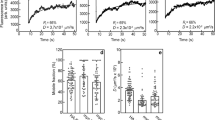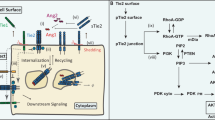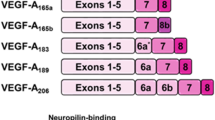Abstract
Angiopoietins are a recently discovered family of angiogenic factors that interact with the endothelial receptor tyrosine kinase Tie2, either as agonists (angiopoietin-1) or as context-dependent agonists/antagonists (angiopoietin-2). Here we show that angiopoietin-1 has a modular structure unlike any previously characterized growth factor. This modular structure consists of a receptor-binding domain, a dimerization motif and a superclustering motif that forms variable-sized multimers. Genetic engineering of precise multimers of the receptor-binding domain of angiopoietin-1, using surrogate multimerization motifs, reveals that tetramers are the minimal size required for activating endothelial Tie2 receptors. In contrast, engineered dimers can antagonize endothelial Tie2 receptors. Surprisingly, angiopoietin-2 has a modular structure and multimerization state similar to that of angiopoietin-1, and its antagonist activity seems to be a subtle property encoded in its receptor-binding domain.
This is a preview of subscription content, access via your institution
Access options
Subscribe to this journal
Receive 12 print issues and online access
$189.00 per year
only $15.75 per issue
Buy this article
- Purchase on Springer Link
- Instant access to full article PDF
Prices may be subject to local taxes which are calculated during checkout





Similar content being viewed by others
References
Davis, S. et al. Isolation of angiopoietin-1, a ligand for the TIE2 receptor, by secretion-trap expression cloning. Cell 87, 1161–1169 (1996).
Suri, C. et al. Requisite role of angiopoietin-1, a ligand for the TIE2 receptor, during embryonic angiogenesis. Cell 87, 1171–1180 (1996).
Maisonpierre, P.C. et al. Angiopoietin-2, a natural antagonist for Tie2 that disrupts in vivo angiogenesis. Science 277, 55–60 (1997).
Valenzuela, D.M. et al. Angiopoietins 3 and 4: diverging gene counterparts in mice and humans. Proc. Natl. Acad. Sci. USA 96, 1904–1909 (1999).
Yancopoulos, G.D. et al. Vascular-specific growth factors and blood vessel formation. Nature 407, 242–248 (2000).
Gale, N.W. et al. Angiopoietin-2 is required for postnatal angiogenesis and lymphatic patterning, and only the latter role is rescued by angiopoietin-1. Dev. Cell 3, 411–423 (2002).
Jones, N., Iljin, K., Dumont, D.J. & Alitalo, K. Tie receptors: new modulators of angiogenic and lymphangiogenic responses. Nat. Rev. Mol. Cell. Biol. 2, 257–267 (2001).
Teichert-Kuliszewska, K. et al. Biological action of angiopoietin-2 in a fibrin matrix model of angiogenesis is associated with activation of Tie2. Cardiovasc. Res. 49, 659–670 (2001).
Mochizuki, Y., Nakamura, T., Kanetake, H. & Kanda, S. Angiopoietin 2 stimulates migration and tube-like structure formation of murine brain capillary endothelial cells through c-Fes and c-Fyn. J. Cell Sci. 115, 175–183 (2002).
Cunningham, B.C. et al. Dimerization of the extracellular domain of the human growth hormone receptor by a single hormone molecule. Science 254, 821–825 (1991).
de Vos, A.M., Ultsch, M. & Kossiakoff, A.A. Human growth hormone and extracellular domain of its receptor: crystal structure of the complex. Science 255, 306–312 (1992).
Schlessinger, J., Lax, I. & Lemmon, M. Regulation of growth factor activation by proteoglycans: what is the role of the low affinity receptors? Cell 83, 357–360 (1995).
Davis, S. et al. Ligands for EPH-related receptor tyrosine kinases that require membrane attachment or clustering for activity. Science 266, 816–819 (1994).
Procopio, W.N., Pelavin, P.I., Lee, W.M. & Yeilding, N.M. Angiopoietin-1 and -2 coiled coil domains mediate distinct homo-oligomerization patterns, but fibrinogen-like domains mediate ligand activity. J. Biol. Chem. 274, 30196–30201 (1999).
Doolittle, R.F. Fibrinogen and fibrin. Annu. Rev. Biochem. 53, 195–229 (1984).
Wen, J., Arakawa, T. & Philo, J.S. Size-exclusion chromatography with on-line light-scattering, absorbance, and refractive index detectors for studying proteins and their interactions. Anal. Biochem. 240, 155–166 (1996).
Suri, C. et al. Increased vascularization in mice overexpressing angiopoietin-1. Science 282, 468–471 (1998).
Thurston, G. et al. Leakage-resistant blood vessels in mice transgenically overexpressing angiopoietin-1. Science 286, 2511–2514 (1999).
Thurston, G. et al. Angiopoietin-1 protects the adult vasculature against plasma leakage. Nat. Med. 6, 460–463 (2000).
Karlsson, R., Michaelsson, A. & Mattsson, L. Kinetic analysis of monoclonal antibody-antigen interactions with a new biosensor based analytical system. J. Immunol. Methods 145, 229–240 (1991).
Johnsson, B., Lofas, S. & Lindquist, G. Immobilization of proteins to a carboxymethyldextran-modified gold surface for biospecific interaction analysis in surface plasmon resonance sensors. Anal. Biochem. 198, 268–277 (1991).
Edgell, C.J., McDonald, C.C. & Graham, J.B. Permanent cell line expressing human factor VIII-related antigen established by hybridization. Proc. Natl. Acad. Sci. USA 80, 3734–3737 (1983).
Acknowledgements
We gratefully acknowledge D. Datta, K. Lamb, A. Polotskaia, and S. Xu for excellent technical assistance, and N. Stahl for insightful conversations and advice.
Author information
Authors and Affiliations
Corresponding author
Ethics declarations
Competing interests
The authors are employees of Regeneron Pharmaceuticals, Inc., or Procter and Gamble Pharmaceuticals.
Rights and permissions
About this article
Cite this article
Davis, S., Papadopoulos, N., Aldrich, T. et al. Angiopoietins have distinct modular domains essential for receptor binding, dimerization and superclustering. Nat Struct Mol Biol 10, 38–44 (2003). https://doi.org/10.1038/nsb880
Received:
Accepted:
Published:
Issue Date:
DOI: https://doi.org/10.1038/nsb880
This article is cited by
-
Angiogenic signaling pathways and anti-angiogenic therapy for cancer
Signal Transduction and Targeted Therapy (2023)
-
An engineered tetra-valent antibody fully activates the Tie2 receptor with comparable potency to its natural ligand angiopoietin-1
Scientific Reports (2021)
-
Signaling pathways and intervention therapies in sepsis
Signal Transduction and Targeted Therapy (2021)
-
The Tie2 signaling pathway in retinal vascular diseases: a novel therapeutic target in the eye
International Journal of Retina and Vitreous (2020)
-
Angiopoietins bind thrombomodulin and inhibit its function as a thrombin cofactor
Scientific Reports (2018)



